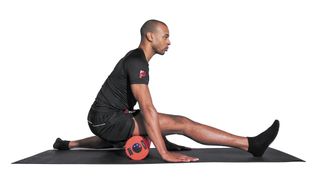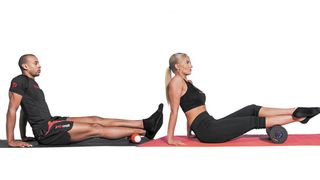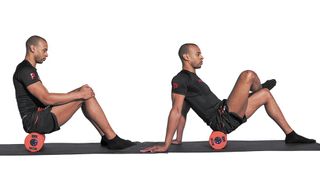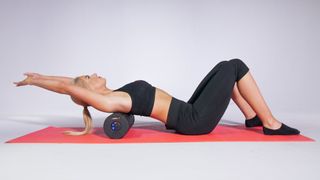Essential Foam Rolling Exercises For Runners
Look after your muscles with this six-move foam-rolling routine

Recovery is an essential part of any well-rounded running training plan, especially a marathon training plan, and yet it’s one people often neglect.
The first step in any good running recovery routine should be stretching, not least because it’s free. Start with this post-run stretching routine then add in some yoga for runners as time allows.
Beyond that, we highly recommend learning how to use a foam roller. While you need to buy a piece of equipment, foam rolling can provide similar benefits to getting sports massages at a small fraction of the price.
Foam rolling, like sports massage, is usually a slightly painful experience, but it’s worth it because foam rolling can relieve the tightness in your muscles and boost blood flow so your post-run recovery process is quicker and more effective.
First off, you’ll need a roller, and our guide to the best foam rollers can help you take care of that. Then you’ll need to know what to do with it, which is where this six-move foam rolling routine for runners can help. It’s been created by ultrarunner and coach Luke Tyburski, who is an ambassador for Pulseroll, which makes a vibrating foam roller.
About our expert
Luke Tyburski is an endurance adventurer and coach. He has completed ultramarathons, double Ironmans and other multi-disciplinary challenges, and coached many ultramarathon runners and triathletes. He holds a BSc in kinesiology and exercise science, and has completed the Australian Institute of Fitness’s certificates 3 and 4 in strength and conditioning training.
Foam Rolling Exercises For Runners
Hamstrings

Why A big group of muscles that you rely on when running. The hamstrings are key to running uphill, so if you’re smart enough to include hill training pay extra attention here.
Get the Coach Newsletter
Sign up for workout ideas, training advice, reviews of the latest gear and more.
How Place the roller under the middle of the back of your upper leg and, using your arms for support, roll forward and back along the roller.
How long Spend three to five minutes on each leg, adjusting your position every minute.
Calves

Why These muscles are constantly working whenever you are running or walking and most long-distance runners will experience tight, painful and stiff calves at some stage.
How Find the sore spots on the back of your lower leg and put them on the roller. Cross your legs at the ankles so there is a small amount of weight bearing down on the leg that’s resting on the roller. Take deep breaths, and relax your legs into the roller as you breathe out.
How long Spend three to five minutes on each leg, adjusting your position every minute.
Glutes

Why Strong glutes will help you on your way to becoming a strong runner. Arguably these muscles are the most important ones used when running. The glutes are your power factory, but running for long periods can mean they get pretty beaten up, so foam rolling the area regularly is important. You need your glutes to be supple, because having tight glutes can start to affect how your pelvis sits, or even potentially twist and rotate your pelvis area.
How Lie back on the roller with a straight leg on the side you are rolling. Your opposite leg should be bent at the knee, with your foot on the floor. Keep your head relaxed and use your hands and the foot on the floor to gently slide backwards and forwards over the roller.
How long Spend three to five minutes on each side, adjusting your position every minute.
Quads

Why The quads carry us forwards with each stride, help us up hills, and decelerate us when we are running out of control down hills, so it’s worth spending plenty of time looking after them.
How Lie face down with the roller under your quad. It should feel like your entire body is sinking into the floor. Remember to not hold your breath.
How long Spend three to five minutes on each leg, adjusting your position every minute.
Upper back

Why There are many things that negatively affect upper back posture – running for many hours, sitting at a desk or in a car all day, or spending long periods of time on your phone. Your chest becomes tight and shortened, and your upper spine can begin to flex rather than extend, which may bring on pain.
Using a roller to lengthen your spine, specifically the thoracic section, has been shown to help with breathing, having a more relaxed diaphragm, and reducing pain in the upper back region – all things that can help a runner’s performance.
How Lie back on the roller which should be positioned around your mid to upper back. Relax your head, and let your hips and bottom rest on the floor while you take deep, even breaths, moving along your upper spine and spending five deep breaths on each vertebrae.
How long Spend three to five minutes rolling your back, adjusting your position every five breaths.

Nick Harris-Fry is a journalist who has been covering health and fitness since 2015. Nick is an avid runner, covering 70-110km a week, which gives him ample opportunity to test a wide range of running shoes and running gear. He is also the chief tester for fitness trackers and running watches, treadmills and exercise bikes, and workout headphones.
